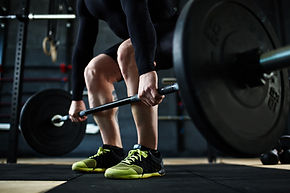
Our Services
FAQs
FAQs
What type of equipment do you use?
-
Barbells form the staple of much of FitMD’s programming, since they are easily loadable, ergonomic, and versatile. Barbells can intimidate beginners, but their use over centuries is testament to their efficacy. Barbells come in all sizes to fit all body types and abilities, from a standard 20 kg barbell (usually rounded to 45 lbs) all the way down to a 5 kg aluminum practice bar (around 11 lbs). Regardless of your skill level, there is a bar to suit your needs, and Dr. V is an industry expert in teaching people how to use them safely and effectively.
-
Dumbbells are a perfectly viable option for clients primarily training at home with access to only dumbbells, or for those who travel frequently and are usually working out at hotel gyms without barbells. Dumbbells, particularly adjustable ones that can be made sufficiently heavy, are space-saving devices that can still get the job done. They can also allow you to train one side of the body at a time. However, they may pose a limitation for particularly strong clients, for whom sufficiently heavy dumbbells often aren’t available (yes, this happens!).
-
Kettlebells are a highly-fashionable piece of exercise equipment that FitMD finds little use for. They are designed for one exercise: the kettlebell swing, which is a good option for training power (how fast you can produce force), and makes a good low-impact alternative to power cleans or box jumps. As an alternative to dumbbells, they are of limited utility. Due to tradition and orthodoxy, kettlebells come in 2-4 kg increments that are not amenable to a program based on steady, incremental loading (sometimes requiring as little as a 2.5 lbs jump between dumbbells). They are also not well-suited as substitutes for many dumbbell exercises such as bench pressing, overhead pressing, or lateral raises.
-
Suspension Trainers (TRX straps) are another trendy piece of exercise equipment that has limited use in FitMD’s training methodology. Suspension trainers are easy to set up, portable, and make group classes interesting. They are also unstable, difficult to master, and hard to quantify. It is difficult to assess progress using TRX straps when the movements they are used for lack distinct starting and stopping points or a reproducible movement pattern. The added instability due to the nature of the apparatus detracts from force production, and therefore strength development. While they may be a viable option for someone stuck in the woods with nothing but a TRX and a sturdy tree branch, for anyone in a situation where better equipment is available, suspension trainers are of little value.
-
Body Weight Exercises (Calisthenics) are how athletes have been getting strong for millenia. Time-tested exercises such as pull-ups, push-ups, and squat variations have served the purposes of Olympians and military personnel since antiquity; but they have their limits. At a certain point of training, the resistance offered by the use of body weight alone is insufficient for further strength adaptation, although other options such as increasing the number of prescribed repetitions or learning advanced variations can keep the athlete progressing for years before that happens. FitMD is a big proponent of eliminating barriers to exercise, particularly lack of equipment availability. That’s why body weight exercises are introduced at some point in every client’s programming.
-
Cardio equipment takes up most of the gym floor at most commercial facilities, not for good reasons. They require minimal to no supervision and often allow the user to watch streaming media while exercising, which has the tendency to detract from any effort they may otherwise put into the task at hand. That’s why the cardio equipment is generally occupied by marginally-active clientele. It is easy to make easy. That’s also why people at gyms who spend all their time on cardio equipment usually see no progress. They don’t want to be there, and are looking for ways to exercise without exercising. While the massive popularity of stationary bike classes enjoyed a surge during the pandemic, it also painted the perception that pedaling in a straight line for 20-60 minutes a day will train your entire body, which is patently absurd. Stationary bikes use a limited range-of-motion, offering little involvement outside of the legs, lungs, and heart. This provides good general conditioning effect, but none of which will make you resemble the perky instructor on the screen.
What does your cardio look like?
-
Despite his criticisms regarding commercial cardio equipment, Dr. V strongly encourages regular cardiorespiratory training, 12-24 minutes daily (duration depends on intensity) at bare minimum. That’s because your body’s ability to use oxygen is one of the best predictors of how long you are going to live. Strength training alone may be enough for a completely sedentary person (at first), but ultimately, everyone should be doing dedicated cardio. Dr. V encourages a mix of regular low-intensity steady-state mixed with 1-2 times a week of high-intensity intervals to meet cardiometabolic needs. This allows for more robust adaptations. High-intensity intervals are introduced into FitMD’s training programs using a prowler or rowing machine, but Dr. V advises clients to meet daily activity guidelines in the low-intensity steady-state zone in whatever way suits their preferences and lifestyle.
What does your nutritional counseling look like?
-
FitMD provides general nutritional guidelines, but it is not our role to prescribe meal plans. In the United States, only a registered dietitian (RD) is legally qualified to prescribe meal plans, and any exercise specialist not holding such a degree would be working out of their scope of practice by doing so. Dietary preferences, lifestyles, and needs vary from person-to-person. There are also a multitude of food allergies, intolerances, metabolic derangements, and malabsorptive conditions that would require specialized attention. While Dr. Maurya holds a medical degree, he serves as an exercise specialist, and does not see clients in any medical capacity.
-
FitMD encourages food tracking so that clients may become familiar with their habits and quantify their macronutrients. This lends personal accountability and awareness. Dr. Maurya understands that sustainable change starts with awareness, but does not suggest tracking indefinitely. It is simply a temporary tool to nurture a healthier relationship with food which is to become a lifelong habit.
What does your exercise programming look like?
-
Dr. Maurya basis his program on linear progression, which is a structured method of increasing the difficulty of an exercise as the body adapts, primarily through increasing the resistance. The initial focus of FitMD’s programming is mastering fundamental movement patterns: squatting, hip-hinging, pushing, and pulling. These movement patterns train the entire body in a way that is optimally efficient, and will form the pillar of FitMD’s programming. These movements patterns, and variations thereof, can be adjusted and modified to fit any fitness level, from frail and elderly to elite athlete. Dr. Maurya is well-versed in adopting movements to fit any potential limitations.
How do semi-private sessions work?
-
FitMD’s programming is extremely streamlined and efficient. Every client’s program is individualized and planned in advance. You can expect to have your training sessions thought out well in advance. As such, semi-private sessions pose no impediment to individual attention. Having company can also help with motivation, as well as save you money. More often than not, clients who Dr. V decides to pair up become friends! To preserve quality of instruction, Dr. V never trains more than 2 people at a time. New, inexperienced clients are often seen for several solo sessions prior to being paired to ensure proper technique and to build rapport.









